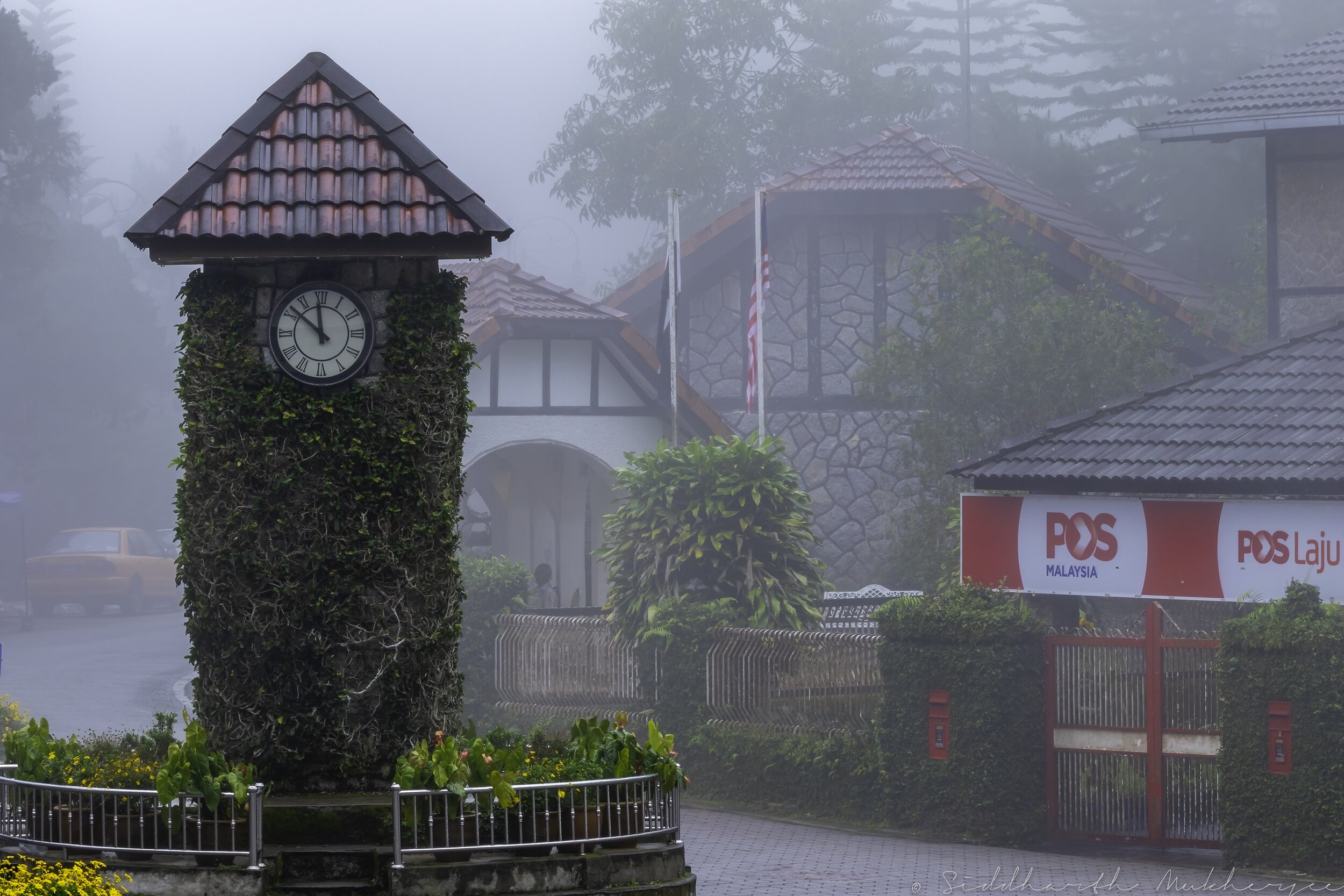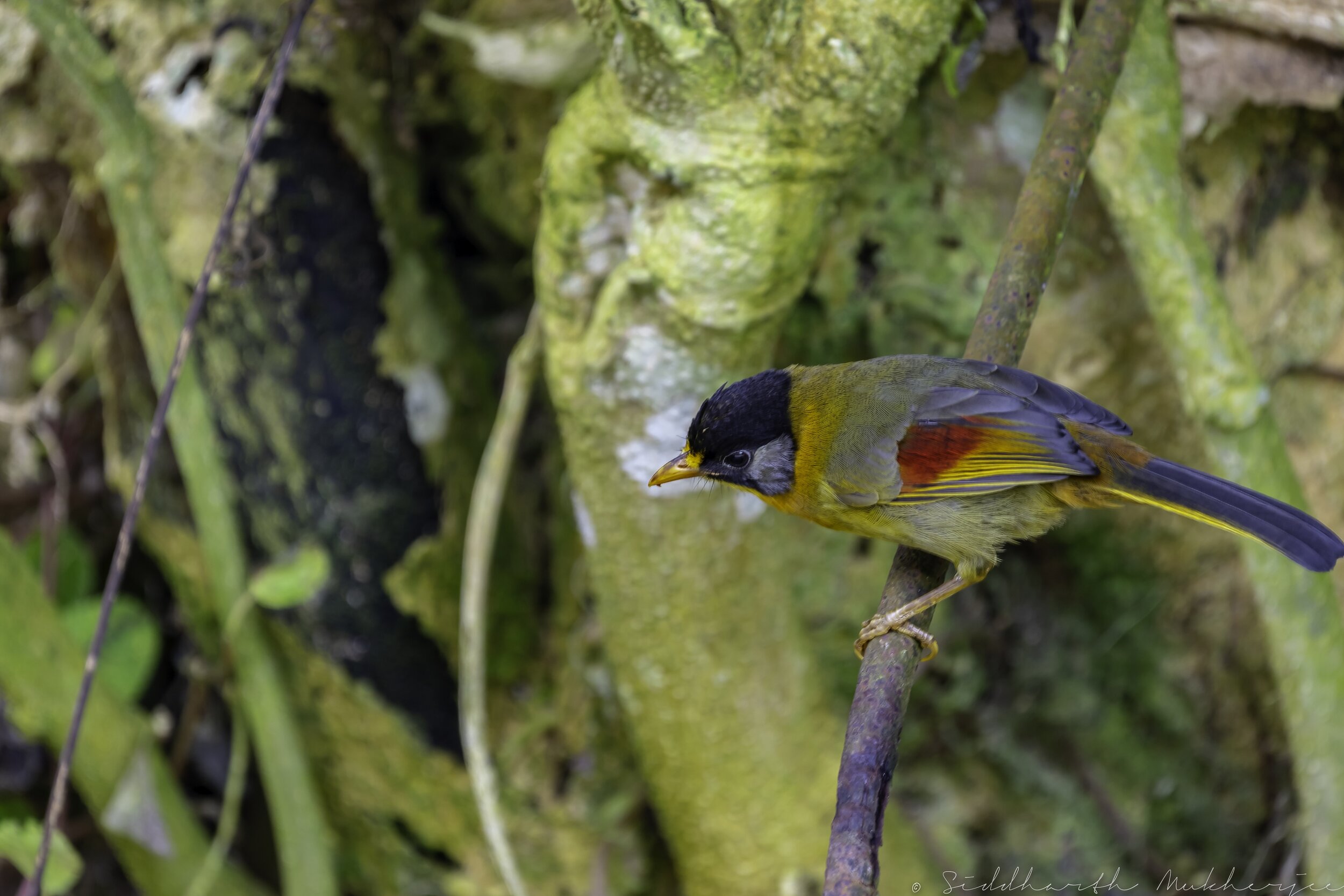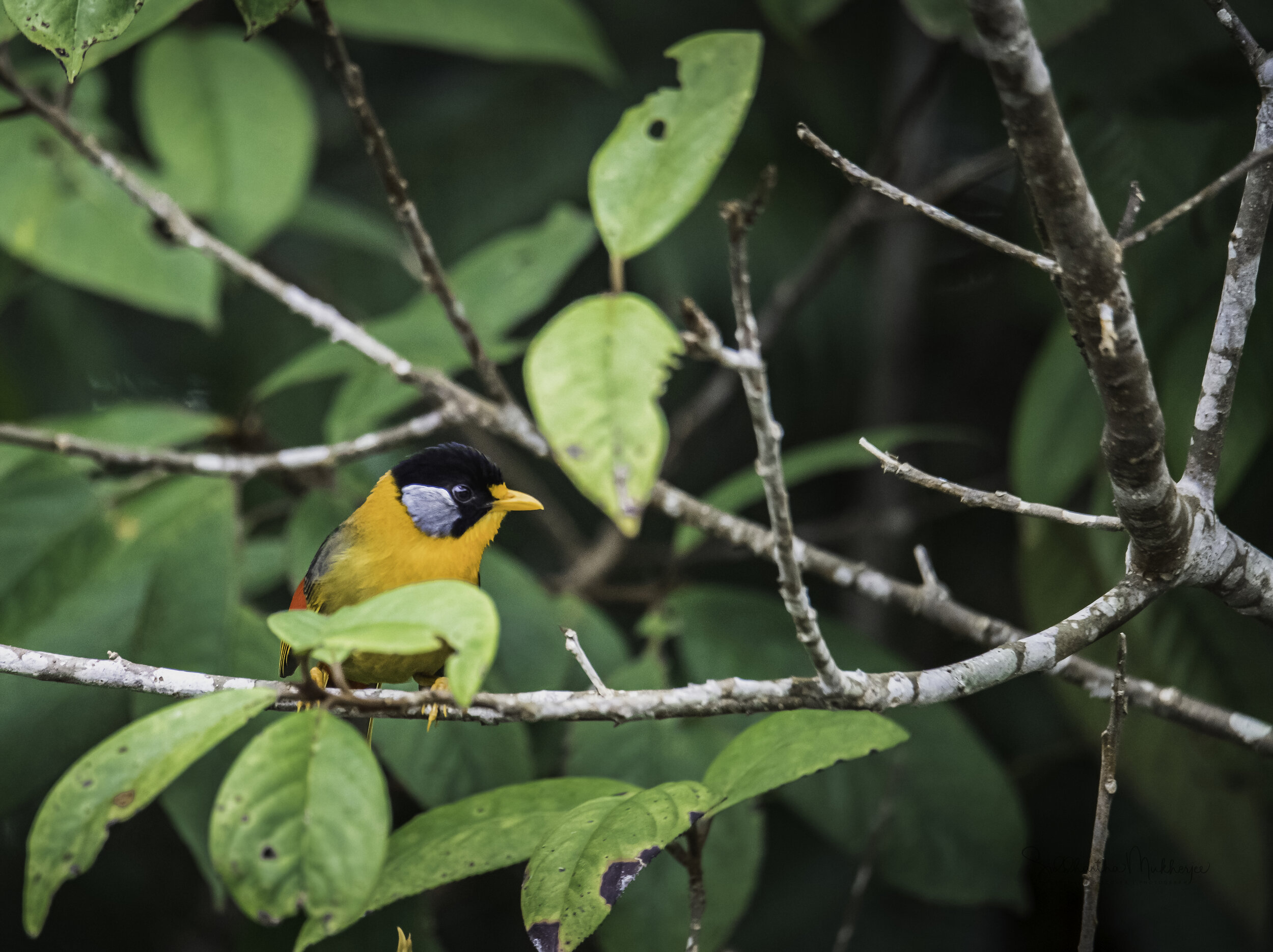Silver-eared Mesia
Leiothrix argentauris
Bukit Fraser, Malaysia
Continuing my wanderings around the pristine evergreen montane forests of Bukit Fraser this time to the right of the watchtower, pictured below, and down the road where the Pahang-Selangor border and the Mager Trail is. We get the first glimpse of another silver shaded bird - the bright and beautiful Silver-eared Mesia.
The Silver-eared Mesia (Leiothrix argentauris) is a species of bird from South East Asia. It was once placed in the large Old World babbler family Timaliidae, but that family has recently been split with this species being placed with the laughingthrushes in the new family Leiothrichidae. The species is sometimes placed in its own genus Mesia, or in the genus Leiothrix with the red-billed leiothrix. There are seven described subspecies, with considerable variation in plumage between them. Further research is needed to establish if this represents a single species or not.
This beautiful small babbler with a black head, bright silver ear, orange underparts, and a bright red wing patch travels in noisy flocks through hill and submontane forest, sometimes in single-species groups and occasionally with other species. Unfortunately a common target of the cage bird trade, escapees are often seen outside of their native range; in some areas, such as Hong Kong, they have even established self-sustaining populations. A warbled song is often given as birds move around in flocks.
But first about Bukit Fraser - one of my favourite destinations in Malaysia. Bukit Fraser or Fraser's Hill is a hill resort located on the Titiwangsa Ridge in the Raub District of Pahang, Malaysia. It is about 100 km, about a two hour drive, from the capital Kuala Lumpur and 400 km away from Singapore in the south. Known locally as Bukit Fraser, this quaint holiday retreat is popular for its nature activities and cool weather. It is one of the last hill stations of Malaysia carrying an imprint of its former British colonial masters very similar to some of the well known hill stations (winter capitals) of India.
Fraser's Hill is mountainous terrain where the altitude ranges between 320 m (1,050 ft) and 1,460 m (4,790 ft) above sea level. Around 44% of the terrain area is ranked as steep, while flat areas make up 8% of the overall land area. Fraser's Hill's virgin forest coverage is around 92% of the overall land area, with only 1.5% of the area used for a town. 6.5% of the forest area has been cleared for secondary vegetation. Ten river systems in Malaysia originate in Fraser's Hill, including Sungai Selangor, a major water source for the district of Selangor, and Sungai Teranum, which forms a major river system in eastern Pahang. The geology of the area is predominantly granite, which forms sandy, permeable soil and is easily eroded.
Fraser’s Hill has its roots in the 1890s, when Scottish prospector Louis James Fraser opened up a tin mining community known as Pamah Lebar. Mining activity there was short lived as the tin ore depleted by 1913. This led many miners and farmers to abandon the area and Fraser reportedly disappeared in 1910, but research in 2019 concluded that he retired from his position and returned to Great Britain in 1910. He died in 1916 while travelling in Austria-Hungary. An attempt in 1917 by Charles James Ferguson-Davie, the then bishop of Singapore, to locate Fraser in the area failed. While he searched for Fraser, Ferguson -Davie recognized the area's potential as a suitable location to set up a hill station and provided his suggestions to the high commissioner and chief secretary of the Federated Malay States. Its cool climate made Pamah Lebar an ideal retreat to escape from the usually hot climate in Malaysia and construction began in October 1919 to convert the mine area into a resort. The site was renamed Fraser's Hill and opened to visitors in 1922 and the erstwhile location of Fraser’s tin mine became the location of its golf course.
Subsequent development occurred in the 1970s in response to increased tourism activity. While this provided room for more visitors, it had an impact on the environment including deforestation and water pollution prompting a halt to further developments in April 2010. More species faced extinction and the water pollution affected the lives of the Orang Asli (first people) and residents in nearby villages. These issues led to the Pahang state government ruling out further development in the virgin forest at Fraser's Hill on 13 April 2010.
Fraser's Hill is known for its vast biodiversity which attracts scientists and researchers. In recent years, it has seen an increase in tourist activities including hiking, cycling, golfing, archery, riding, tennis, swimming and squash. With its tiny population of 1,000, as recorded in 2013, it is one of Malaysia’s most unexpectedly satisfying short-stay destinations. Navigating up the tight twists and turns of the road to this hill station is a stimulating experience – in fact the uphill road is so narrow that the final eight kilometre stretch is limited to one-way traffic at any time. The direction changes every hour; odd hours are for ascending the hill, while even hours have been denoted for descending traffic. With a majority of its buildings featuring mock Tudor-style architecture, Fraser’s Hill hasn’t changed much from its days as a British colonial hill resort. Besides the essential photo stop opportunity at Fraser’s Clocktower, a hard-to-miss clock tower which stands in the old English village square, you can head on down to Allen’s Water, a former reservoir turned into a boating and fishing attraction.
Akin to a tiny Scottish hamlet, Fraser’s Hill is one of Malaysia’s premier locations for bird-watching. Avid bird watchers can take advantage of the fact that Fraser’s is home to over 250 species of birds – the Fraser’s Hill Development Corporation and the World Wildlife Fund both run classes and excursions to see the flora and wildlife of the hill station. What's more, the Fraser’s Hill International Bird Race – a contest to document the vast variety of birdlife on the mountainside – is typically held here in June. There are eight nature walk trails available ranging from easy to hard. For example the Maxwell Trail – a short and easy hike or the six-kilometre Pine Tree Trail – a longer trail that takes one past some dramatic views and ends near the 18 foot Jeriau Waterfall located about five kilometres from the town centre. Fraser’s also plays host to the Royal Fraser’s Hill Golf Course – a nine-hole green that is one of Malaysia’s oldest. There’s also a paddock at the eastern edge of the course where one can saddle up for a horse riding session.
With that said, let’s get back to the Silver-eared Mesia.
‡‡‡‡‡
Silver-eared Mesia
The Mesia, also called Silver-eared Mesia, or Silver-ear (Leiothrix argentauris) is a song bird of the babbler family Timaliidae. It is found from Pakistan through the Indochinese peninsula in scrub and secondary jungle. This 15 centimetre (6 inch) long bird is olive above and yellow below, with a black crown, silver ear patches, and some crimson on the tail. In groups of 6 to 30 it travels about the forest bushes and canopy seeking berries and peering under leaves for insects. Four eggs are laid in a cup-shaped nest. The mesia has a sweet, whistling song and is sometimes kept as a cage bird.
The Leiothrix, a genus of birds of the babbler family Timaliidae (order Passeriformes), with two species: the silver-eared mesia, or silver-ear (L. argentauris), and the red-billed leiothrix (L. lutea), which is known to cage-bird fanciers as the Pekin, or Chinese, robin (or nightingale). Both range from the Himalayas to Indochina; L. lutea has been introduced into Hawaii, where it is commonly called hill robin. The silver-ear has yellow, gray, red, and black markings; the “robin” has a golden throat, orange or red breast, yellow wings marked with blue (and red, in the male), and a blue-tipped tail that is forked and out-curved. Both species are 15 cm (6 inches) long and have brief, sweet songs.
The diet of the silver-eared mesia is dominated by insects and their larvae, as well as fruit and to a lesser extent seeds. A study of the diet of feral birds in Hong Kong found that 87% of the faecal samples studied had the remains on insects in them, and 97% had the remains of fruit. The species will often associate in large groups of up to thirty individuals while foraging, and even forms groups during the breeding season. They will also join large flocks of other species in the forest, known as waves, which include other species of babblers. They generally feed closer to the ground, but may go as high as 5 metres up into the canopy.
The silver-eared mesia is a seasonal breeder, with the season lasting from November to August, although the season starts later, in April, in the northern part of its range. Both the male and female are involved in building the nest, a deep cup of bamboo and other dead leaves lined with rootlets and fern fibres. The nest takes about four days to construct and is placed near ground level or up to 2m up in a bush. Underlying its relationship with the red-billed leiothrix the nest is said to be indistinguishable from the one of that species.
This species has an extremely large range, and hence does not approach the thresholds for Vulnerable under the range size criterion despite the fact that the population trend appears to be decreasing, the decline is not believed to be sufficiently rapid to approach the thresholds for Vulnerable under the population trend criterion (>30% decline over ten years or three generations). The population size has not been quantified, but it is not believed to approach the thresholds for Vulnerable under the population size criterion (<10,000 mature individuals with a continuing decline estimated to be >10% in ten years or three generations, or with a specified population structure). For these reasons the species is evaluated as Least Concern.
The following gallery is of this beautiful silver ear - observed & photographed at Fraser’s Hill. The photos are from various trips I have made to this quaint little village town.
‡‡‡‡‡
This is a species under extreme pressure due to trapping and harassment. The open availability of high-quality recordings of these species can make the problems even worse. For this reason, I do not have any songs shared here.
‡‡‡‡‡
Related Posts
































